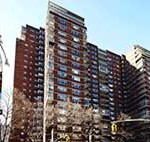Cadman Towers was in a bind.
The 421-unit Brooklyn Heights co-op needed $62 million in repairs but already had five mortgages and couldn’t borrow what it needed because it’s a Mitchell-Lama. The state program’s strict affordability rules give owners virtually no equity.
So the building, 10 Clinton Street, went where no Mitchell-Lama had gone before: It converted to an HDFC co-op. The transaction, which received City Council approval in April, closed this week.
New York had passed a law a decade ago making the switch possible, but it is complicated process.
“Cadman Towers was the first to take the plunge,” said Erica Buckley, a partner at Nixon Peabody who worked on the transaction as the co-op’s special counsel. “It was a lot of work.”
For affordable housing nerds, it was a labor of love — and perhaps a breakthrough, paving a route for other Mitchell-Lamas that need financial flexibility but want to remain affordable.
A necessary step was getting shareholders to vote in favor, and last summer, 77 percent did, despite some internal opposition. They can now sell their units for prices affordable to buyers earning 80 percent of the area median income, which is substantially more than the $70,000 to $90,000 they could get as Mitchell-Lama shareholders.
That gives them an immediate boost in equity, but sellers must surrender half of their profit to the building. The revenue boost will help the co-op finance the repairs.
The biggest losers in the switch are those who have spent years on a waiting list to buy into the building. The list was wiped out. Buyers must now win the city’s affordable housing lottery to get in.
The Mitchell-Lama and HDFC programs both keep properties affordable by limiting resale prices. The co-op owners, technically shareholders, enjoy the security of low-cost homeownership but without the upside of building up equity that can be cashed out for huge sums, especially in wealthy neighborhoods like Brooklyn Heights.
But there are key differences between the programs, which exist under the Private Housing Finance Law — Mitchell Lamas under Article II and HDFCs under Article XI.
For one, Mitchell-Lama regulatory agreements last for 30 or 40 years and produce a lot of drama when opportunities to leave the program appear. Shareholders at 10 Clinton Street got a 99-year lease.
Also, Mitchell-Lama co-ops operate with minimal oversight, which has led to scandals, while HDFC co-ops are assigned a city-approved monitor, which in 10 Clinton Street’s case will be Habitat for Humanity’s Westchester chapter.
Article II targets low, middle and moderate income households, and Article XI makes funding available to convert “seriously deteriorating” residential properties to well-managed housing for low-income households.
“The Article 2 to Article 11 Program is a great option for many aging Mitchell-Lama co-ops that want to remain affordable but reorganize themselves to meet current operational needs,” said Buckley, who helped put the program in place in 2013 when she worked for the state’s attorney general.
Some Mitchell-Lama supporters, however, are not fans of Article XI.
A group called Cooperators United for Mitchell-Lama calls such conversions “detrimental to all the major parties involved,” including shareholders who remain residents, prospective buyers on the wiped-out waiting list and people buying into the HDFC.
“Only a thin slice of New Yorkers would benefit from such a conversion,” the group asserts on its website, “namely, current shareholders who move out immediately following conversion either by selling their apartments at prices much higher than Mitchell-Lama equity or by passing them to their heirs.”
But Buckley noted that although units in HDFC co-ops cost more, purchasing them is easier because buyers can use traditional mortgages. Mitchell-Lama units generally have to be bought with cash, and most moderate-income New Yorkers do not have enough.
HDFC conversions, she said, are “a really solid alternative to privatization.”
Read more



